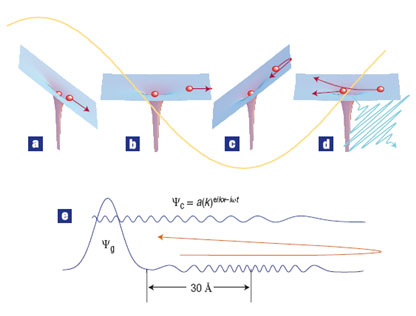|
2. Principle & result
The producing of attosecond pulse can be explained briefly by three-step model[1].
Step 1: Ionization. When induced by a strong (near-)infrared laser field, ionization can be approximated by tunnelling; An electron in atom or molecule is extracted.(figure 1-a, 1-b)[2]
Step 2: Motion after liberation. A typical electron will gain a kinetic energy of ~50?1,000 eV from the field during its first femtosecond of freedom, representing tens to hundreds of photons (figure 1-c)
Step 3: Recollision. On re-encountering the core, the electron scatters from its
parent ion. In this time, An attosecond XUV pulse is generated(figure 1-d)
figure 2 is simulation result of single attosecond pulse generation using 2-color laser field. 
Figure 1 Creating an attosecond pulse. An Intense femtosecond near-infrared pulse (shown in yellow) extracts an electron wavepacket from an atom or molecule (a). Initially, the electron is pulled away from the atom (a, b), but after the field reverses, the electron is driven back (c) where it can ¡®recollide¡¯ during a small fraction of the laser oscillation cycle (d). The parent ion sees an attosecond electron pulse. (e), The quantum mechanical perspective. 
Figure 2 High harmonic spectrum (a) and 130as isolate attosecond pulse shape by direct fourier trans formation (b) and 60 as fourier limited pulse (c) and time-frequency analysis (d) at 11fs 800nm and 64fs 1840nm without phase difference between two pulses.
3. Future plan
1. 2-color experiment to generate shorter attosecond pulse.
2. HHG from ion channel.
3. A direct attosecond pulse measure using electron spectrometer.
4. References
[1] Plasma Perspective on Strong-Field Multiphoton Ionization, P.B Corkum Phy. Rev. Lett. 71 1994 (1993)
[2] Attosecond science, P.B Corkum and Ferenc Krausz. Nature Physics 3 381 (2007)
| 
